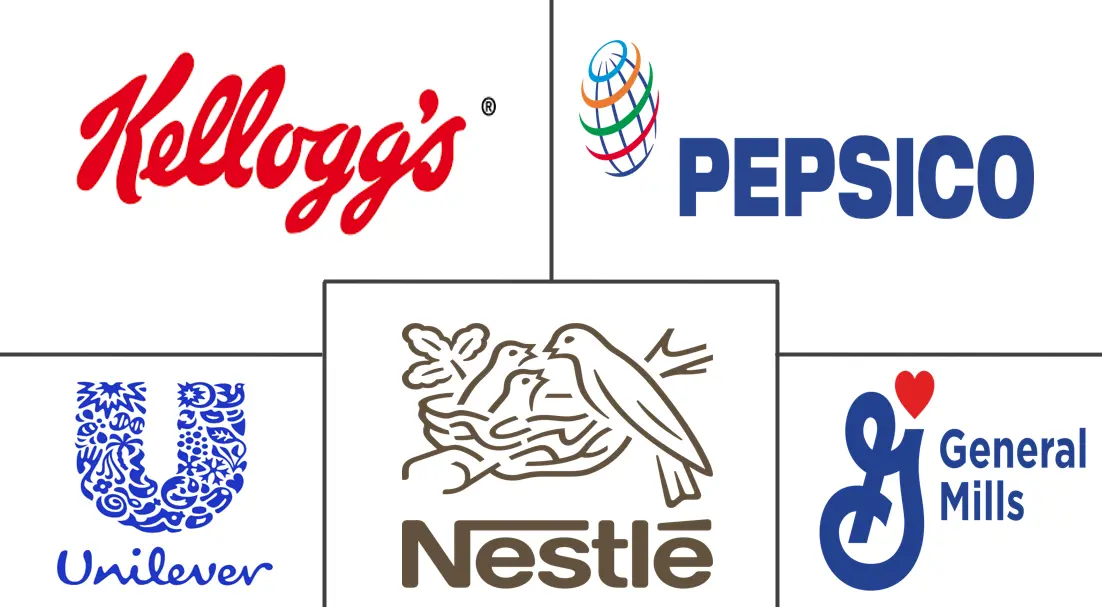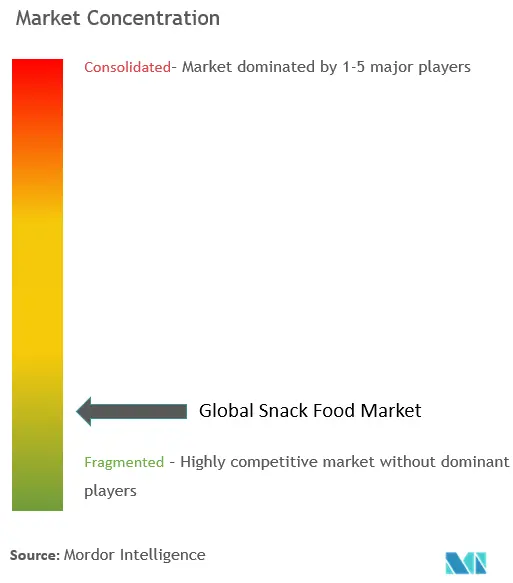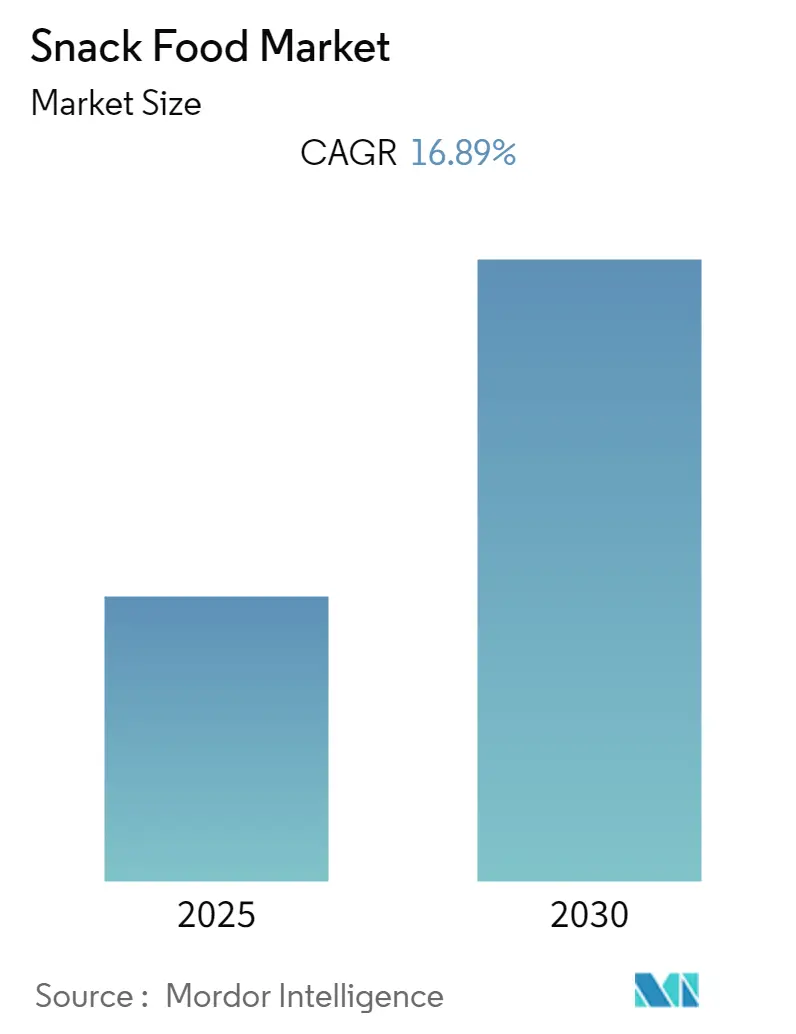
Snack Food Market Analysis
The Snack Food Market is expected to register a CAGR of 16.89% during the forecast period.
- Consumers prefer their food to be easy to carry and quickly accessible, making snack food the best option. Witnessing the sudden upsurge, manufacturers eventually launched products enriched with protein, vitamins, and nutrients, giving consumers on-the-go nutrition while snacking. Healthy alternatives have emerged on the market as a result of consumer desire for options for low-fat, low-sugar, and high-protein snacks. Functional snacking is gaining more importance these days as people are replacing their meals with snacks and need proper nutrition through snacking.
- According to the 2021 report of Mondelez International about snacking habits, 72% of people look for portion-controlled snacking options, which means they require their nutrition needs to be fulfilled by snacking. The variety of products available on the snack food market, which cater to a variety of tastes and preferences, includes chips, nuts, granola bars, and more. The demand for snacks produced from natural and sustainable ingredients has also increased as plant-based diets and clean-label preferences have grown in popularity.
- Over the medium term, snack food emerged as an alternative to full-fledged meals with a paradigm shift in consumer behavior patterns. Snacks are evolving to cater to changing demand as empowered consumers increasingly seek tasty, nutritional, and sustainable foods to fuel their on-the-go lifestyles.
- For instance, 31% of consumers in the United States consumed snack food once a day in May 2023, according to the International Food Information Council. Snacking is on the rise as the demand for convenience and portability fuels consumption, with premiumization spurring innovation and variety in fresh, better-for-you, and functional snacks. Localization encourages the use of bold and spicy flavors and exotic ingredients to appeal to global palates, driving growth in the regional markets. Convenience also drives the online sales of ready-to-eat snacks, with snack foods being one of the top food categories purchased through e-commerce channels.
Snack Food Market Trends
Rising Demand for Convenient Foods Drives the Market
- Modern consumers frequently need help to sit down for traditional meals, especially those with busy schedules. While on the go, snack foods offer a quick and convenient option to fulfill appetites and control hunger. Many nuclear families live in big cities, and due to both parents working, the kids have a habit of snacking at least once a day instead of having a whole meal.
- Snacks are often portable and packaged for ease of use, making them appropriate for consumption in a variety of locations, including offices, vehicles, and public transportation. Customers can quickly grab snacks while traveling or in urban areas because of convenience stores and vending machines. More people are moving into cities, which promotes a culture of convenience where snacks can be used as functional meal replacements, driving the snack food market.
- Many people munch while at work since it is handy and keeps their energy levels up without disrupting their work. Consuming snacks while watching films, sporting events, streaming entertainment, and partying at home is a common practice. For instance, 45% of Indians preferred party and celebration occasions for snack consumption in November 2022, according to the report published by Godrej Yummiez.
- Customers can browse and order a large variety of snacks online from the comfort of their homes, greatly boosting convenience. According to the Campaign Middle East, snack food is the fastest-growing e-commerce category in the United Arab Emirates, with a growth rate of 855% in 2022.
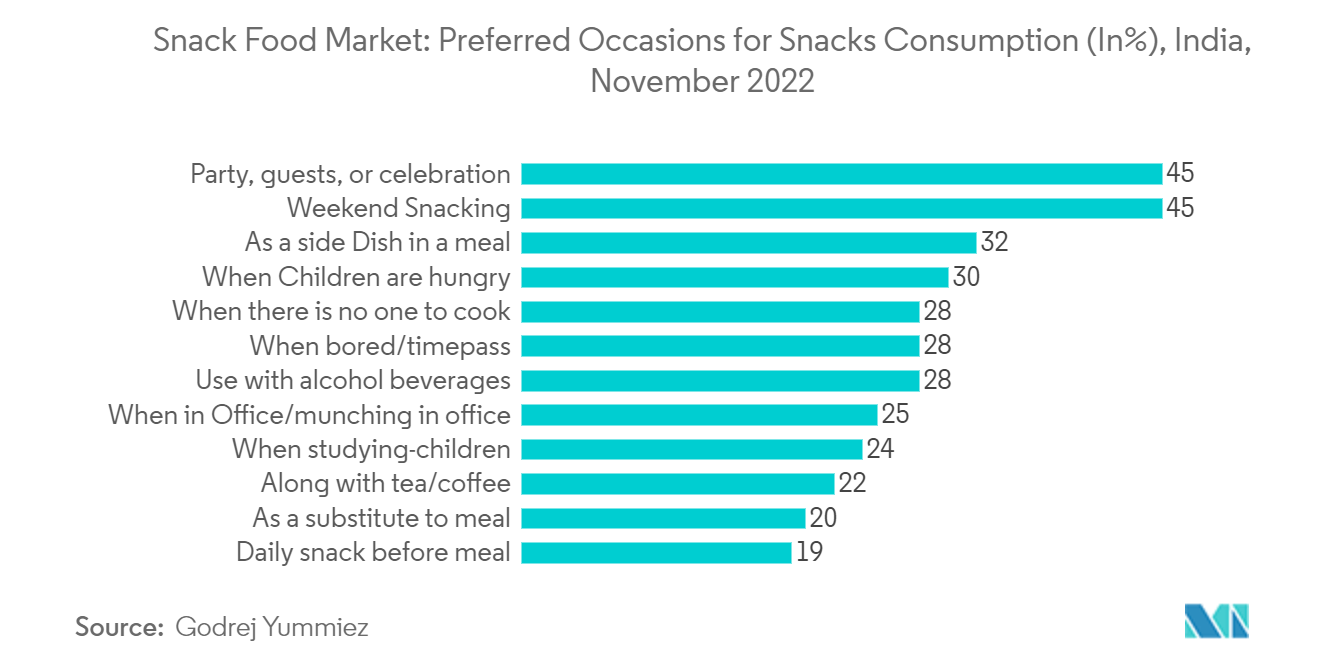
Asia-Pacific Holds the Largest Market Share
- Snack food products are largely consumed in developing regions with high commercialization and urbanization. Asia-Pacific represents the largest and fastest-growing market for snack food products owing to increasing demand from developing countries, such as India and China. The spread of Western eating habits to the developing world and growing urbanization have helped improve market penetration for global players entering the developing nations of Asia-Pacific. For instance, the size of the organized Western savory snacks market in India was INR 242 billion in 2022, according to the Associated Chambers of Commerce and Industry of India.
- The Chinese snack food market registered stable growth in the study period, and it is expected to improve further during the forecast period. Moreover, the rising demand for on-the-go snacking with additional nutritional content is driving the demand for meat-based snacks in the market. Rising numbers of tourists to China and India fuel market expansion. Snacks are a common source of convenient sustenance for tourists and travelers while on trips or while experiencing new places.
- Additionally, the higher protein content and lower fat and carb contents of products augment their demand among sports and fitness enthusiasts. Furthermore, Chinese snack manufacturers are focusing on research and development to innovate healthy snack options. For instance, in April 2023, Dongguan, Guangdong province-based snack maker Hsu Fu Chi, collaborated with the South China University of Technology to develop a healthy snack research center to debut new trends in Chinese consumer preferences.
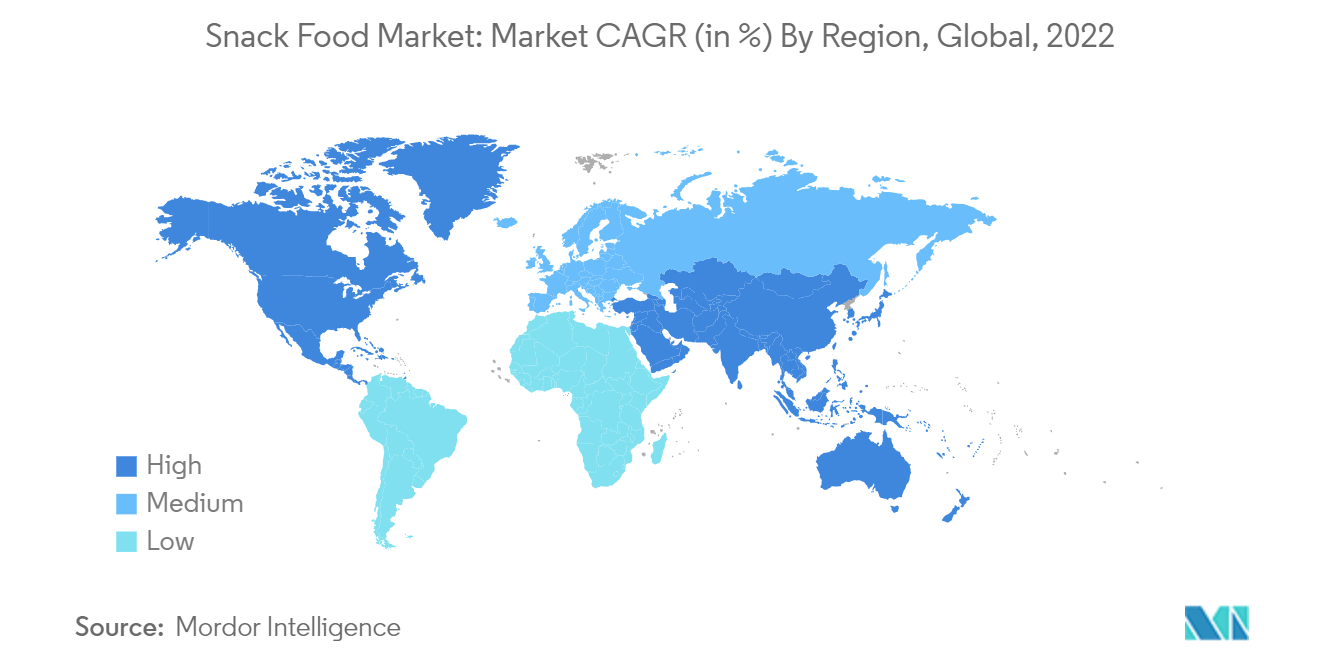
Snack Food Industry Overview
The Snack Food market is fragmented, and the competition in the snack food market is high, mostly in developed countries, where a large number of snack food manufacturing companies are operating. Some of the major players in the snack food market are PepsiCo Inc., The Kellogg Company, Unilever Plc, Nestle SA, and General Mills Inc.
The prominent players are focusing on new product developments, expansions, partnerships, and mergers and acquisitions as strategies to cater to the increasing demand from consumers, thereby gaining a competitive advantage in the market. To strengthen their hold in the market, these companies are innovating their flavors, expanding their target markets, and strengthening their distribution channels. Also, companies compete on different factors, including product offerings, quality, taste, flavors, price, functionality, size, packaging, and marketing activities, to gain a competitive advantage in the market.
Snack Food Market Leaders
-
General Mills Inc.
-
PepsiCo Inc.
-
Kellogg Company
-
Unilever Plc
-
Nestle SA
- *Disclaimer: Major Players sorted in no particular order
Snack Food Market News
- April 2023: PepsiCo's brand Frito-Lay and Quaker announced the opening of its industry-leading Greenhouse Learning Center at its R&D headquarters. The company claims that the establishment will be used to field test, measure, and analyze compostable snack product packaging to speed up the rate of innovation.
- February 2023: Hostess Holdings launched a new snack brand, Kazbars, a 'first-of-its-kind' innovation within the snack cakes market. The introduction of Kazbars, which is inspired by candy bars, provides a distinctive product to the category of snacks. Hostess is one of the companies in the snacking industry with the fastest growth.
- March 2022: Mondelez International Inc. acquired Chipta SA, a high-growth key player in the Central and Eastern European croissants and baked snack category.
Snack Food Industry Segmentation
A snack is a small portion of food eaten between meals. Snacks come in various forms and shapes, including packaged snack foods and other processed foods.
The snack food market is segmented by type, distribution channel, and geography. Based on type, the market is segmented into frozen snacks, savory snacks, fruit snacks, confectionery snacks, bakery snacks, and other types. Based on distribution channels, the market is segmented into supermarkets/hypermarkets, convenience stores, specialty stores, online retail stores, and other distribution channels. Based on geography, the market is segmented into North America, Europe, Asia-Pacific, South America, and the Middle East and Africa.
The market sizing has been done in value terms in USD for all the abovementioned segments.
| Type | Frozen Snacks | ||
| Savory Snacks | |||
| Fruit Snacks | |||
| Confectionery Snacks | |||
| Bakery Snacks | |||
| Other Types | |||
| Distribution Channel | Supermarkets/Hypermarkets | ||
| Convenience Stores | |||
| Specialty Stores | |||
| Online Retail Stores | |||
| Other Distrbution Channels | |||
| Geography | North America | United States | |
| Canada | |||
| Mexico | |||
| Rest of North America | |||
| Europe | Spain | ||
| United Kingdom | |||
| Germany | |||
| France | |||
| Italy | |||
| Russia | |||
| Rest of Europe | |||
| Asia-Pacific | China | ||
| Japan | |||
| India | |||
| Australia | |||
| Rest of Asia-Pacific | |||
| South America | Brazil | ||
| Argentina | |||
| Rest of South America | |||
| Middle East and Africa | South Africa | ||
| Saudi Arabia | |||
| Rest of Middle East and Africa | |||
Snack Food Market Research FAQs
What is the current Snack Food Market size?
The Snack Food Market is projected to register a CAGR of 16.89% during the forecast period (2025-2030)
Who are the key players in Snack Food Market?
General Mills Inc., PepsiCo Inc., Kellogg Company, Unilever Plc and Nestle SA are the major companies operating in the Snack Food Market.
Which is the fastest growing region in Snack Food Market?
North America is estimated to grow at the highest CAGR over the forecast period (2025-2030).
Which region has the biggest share in Snack Food Market?
In 2025, the Asia-Pacific accounts for the largest market share in Snack Food Market.
What years does this Snack Food Market cover?
The report covers the Snack Food Market historical market size for years: 2019, 2020, 2021, 2022, 2023 and 2024. The report also forecasts the Snack Food Market size for years: 2025, 2026, 2027, 2028, 2029 and 2030.
Our Best Selling Reports
Snack Food Industry Report
The global snacks market, significantly valued in recent years, bolstered by shifting consumer lifestyles that favor convenient, portable, and healthier snacking options. Amid busy schedules, snacks are increasingly serving as meal replacements and social foods, with savory snacks dominating the market due to their appealing flavors. The integration of cultural diversity, health-conscious eating trends, and advanced food technologies has diversified product offerings, including snacks with enhanced nutritional benefits catering to vegan and allergen-free preferences. The market is robustly supported by extensive distribution networks including supermarkets, hypermarkets, specialty stores, and online platforms, simplifying consumer access and enhancing global consumer engagement. Additionally, the industry sees intense competition, with major companies innovating through new product developments and strategic mergers and acquisitions. Overall, the snacks market is evolving from a casual eatery item to a crucial diet component, indicating a dynamic sector poised for continued innovation and market expansion. For more detailed insights, a comprehensive report is available for PDF download.

